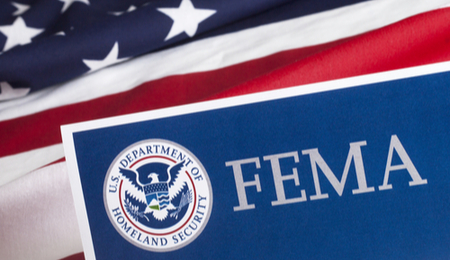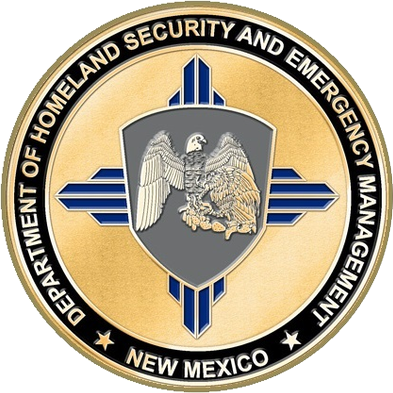Response and Recovery – Draft
The NMDHSEM Response and Recovery Team is responsible for overseeing and coordinating state-level all-hazards emergency response and recovery preparedness, response, recovery and homeland security activities within the state of New Mexico.
The NM Emergency Operations Center (NMEOC) regularly dispatches team members to join local emergency managers, first responders, emergency leaders and those affected by emergencies and/or disasters that threaten public safety and to provide information essential to the public.
Operations TeamOperations Team
Response
New Mexico Department of Homeland Security and Emergency Management Response Team are responsible for state level emergency management preparedness. Along with assisting local governments plan for large scale events the Response Team assists state agencies, local jurisdictions and tribal entities who have been impacted by an emergency. Local Emergency Managers contact the twenty-four hour duty line to inform the New Mexico Emergency Operations Center (NMEOC) of their pending emergency. The Duty Program allows central communication between local, state and federal agencies when an emergency or disaster affects a local jurisdiction within New Mexico. The NMEOC Duty Officer will analyze the situation and advise the Governor’s Authorized Representative (GAR) on the proper course of action.
The Response Team is responsible for supporting partners in times of disaster / emergency. Routinely, public safety personnel and emergency managers respond to natural, technological, or civil emergencies throughout the State of New Mexico. Occasionally, these events reach a magnitude that is beyond the response capability of tribal, local or county level resources. Events of this nature may require the support of adjoining jurisdictions to include cities, tribes, counties, the State of New Mexico, adjoining states, and Federal resources. Given an emergency of extraordinary scale, these events may be formally declared a disaster by the Governor of New Mexico and by the President of the United States. The State of New Mexico’s response to state and federal level disasters are managed in the NMEOC.
The NMEOC exists to gather, process, and report emergency situation intelligence to aid in State policy and decision making; support local communities as they direct and control disaster emergency response operations; and account for the State’s response support costs. In non-disaster conditions, the NMEOC is maintained in an operational status that facilitates a timely response to rapidly evolving emergencies. The NMEOC’s ability to exchange critical disaster information is achieved through diverse and redundant communications technologies.
Communications
- The New Mexico Department of Homeland Security and Emergency Management Communications Team provide technical assistance and support for locals, counties, tribal and federal partners with the development of interoperable communication systems. The Communications Team assists local jurisdictions and state agencies understand radio communications and works closely with them to achieve interoperability within disparate communications systems. Team members coordinate mass notification through local 9-1-1 centers in a coordinated process.
- Interoperability Planning Committee (IPC)At the encouragement of the New Mexico public safety community, the New Mexico Legislature recognized a need for comprehensive and coordinated statewide interoperable communications network and established the Emergency Communications Interoperability act (SB 173-2009) signed April 6, 2009, further creating the Interoperable Communications Policy Commission (IPC). The IPC is responsible for providing policy level direction related to planning, designing, and implementing guidelines, best practices, and standard approaches to address New Mexico’s public safety communications interoperability issues.
Duties of the IPC as outlined in NMSA 12-10D, 1978 as amended
- Development and coordination of a statewide interoperable emergency communications plan in compliance with national incident management system guidelines, including an integrated public safety radio communications system and other coordinated critical information systems, to achieve interoperability within and between local, state, tribal and federal agencies and first responders;
- Implementation of the interoperable emergency communications plan by state and local agencies and shall provide specific directions for methods by which agencies shall implement those strategies;
- Priorities relating to the interoperable emergency communications plan; and
- Other matters relating to planning, development, coordination, promotion and implementation of the interoperable emergency communications plan.”
State Wide Interoperability Communications Working Group (SICWG)
The Statewide Interoperable Communications Working Group (SICWG) was established in 2006 to provide standards for wireless radio communications, researching best practices, facilitating cooperative and contract agreements, ensuring adequate wireless spectrum and reviewing priorities for the statewide radio interoperable needs. The establishment of the formal working group created a team of individuals from organizations around the state with knowledge and interest in the field of wireless radio communications. A sub-team of the SICWG has been established and is referred to as the Core working group (SICWG-C).
Duties of the SICWG as assigned by the IPC:
- Act as communicating agent to state users about mission critical wireless radio communications issues and coordinate a unified state approach.
- Interface with state, federal, tribal and private wireless radio communications advisory groups and regulatory and governing bodies (e.g., SAFECOM, NPSTC, APCO, and Regional Four Corners Committee)
- Identify current infrastructure needs through gap analysis and technology reviews.
- Develop and recommend system standards for wireless radio communications to be used in evaluation and authorization of federal and state funding requests.
- Foster relationships with amateur radio operators and other non-governmental groups to participate in emergency response.
RAVE
As the expectations and needs of communities continue to grow, state and local governments are expected to do more with less. The need to be prepared for any threat or emergency has never been greater. In order to keep communities safe, government officials and public safety agencies have to partner and engage with community members to protect them from unforeseen risks. Communities can rely on Rave’s scalable platform to send internal and external mass notifications and receive critical real-time incident information, all the while increasing efficiency and protecting residents, visitors, vulnerable populations and first responders.
Schools, churches, outdoor events. There are a growing number of soft targets in each of our communities. A delay in notifying 9-1-1 and on-site personnel of an emergency slows down the resolution of any incidents, putting your community’s safety at risk. Technology today enables fast action by those in these soft target locations to send in anonymous tips or trigger a panic button activation to 9-1-1 and on-site personnel. Bystanders and staff on the front lines are able to prevent incidents or shorten their response time with this mobile technology. While the media can be your best partner for sharing and disseminating important community updates, it can also negatively portray your agency following an incident or mistake. You can tap into the power of the media by empowering it to share your agency’s steps to improve community safety and preparedness, like the City of Cincinnati did after a teenager tragically died after being trapped in his car. With regular updates and success stories of your lifesaving technology implementation, the media will work with your agency to share these powerful stories and become a partner in preparing your community for known and unforeseen risks and disasters.
All Hazard Incident Management Team (AHIMT)
The purpose of an all-hazard incident management team (AHIMT) is to assist any New Mexico jurisdiction confronted with an incident beyond its capabilities in either complexity or duration. An AHIMT provides capabilities to an all-hazards incident that can facilitate a robust management framework to support a jurisdiction in stabilizing or bringing an incident to the conclusion. Also, an AHIMT maintains the ability to support the incident as it escalates in complexity or duration requiring a more capable AHIMT to take over.
In New Mexico an AHIMT provides a support role for the local incident command structure (ICS) when an incident has exceeded the capabilities of a jurisdiction. The jurisdiction requesting the assistance of an AHIMT, known as the authority having jurisdiction (AHJ), defines the AHIMT’s role with support from NMEOC representatives providing technical support and assistance through delegated authorities. An AHJ can include a local jurisdiction, state or federal agencies. (NOT SURE IF AHJ CAN BE UTILIZED WITH TRIBAL ENTITIES)
In 2018, the State of New Mexico formed the AHIMT Working Group to develop state standards for individual resources and Type 3 All-Hazard Incident Management Teams. The Type 3 AHIMT working group members are developing task books and guidelines as a standard for the state program. The documents provide guidance for the establishment of minimum standards for incident personnel using these “all-risk” task books and standards.
This initiative is designed to
- Provide incident management for state-level emergencies and disasters regardless of state and/or federal declarations.
- Provide for the interim management of an incident until the arrival of Type 1 or Type 2 team.
- Prepare team personnel for all-hazard incidents.
- Deploy management personnel when local jurisdictions are overwhelmed or for an incident with prolonged operational periods.
- Allow requests for single team resources and not necessarily the entire team.
AHIMTs provide incident management expertise and surge capacity. An AHIMT provides great benefits for the state and local communities, some of whom lack the resources to effectively manage a complex event or incident. Having the added capacity of the AHIMTs at crucial periods when the complexity of an event is growing rapidly has proven to save lives, reduce disaster losses, and resulted in faster incident stabilization with lower cost and faster recovery.

FEMA
FEMA and SBA Recovery Programs
FEMA recovery programs are available after a disaster or emergency declaration is requested by the Governor and granted by the President. SBA programs can be triggered though a Presidential declaration, a SBA declaration, or a USDA declaration. Preliminary damage assessments and information on conditions and circumstances are usually required before a declaration is considered. The NMDHSEM Recovery Team coordinates and facilitates these programs.

Disaster Assistance
If an incident does not rise to the level for a federal disaster declaration, the New Mexico Public Assistance (NMPA) Program may be implemented to provide financial or technical assistance to an impacted community. Funding is to help restore public infrastructure and operations.
State assistance may be available if its:
- Local government has exhausted all local resources, including those that may be available through the Interstate Mutual Aid System (IMAS);
- Chief Elected Official or designee declares an emergency or disaster or notice of intent to declare; and
- Declaration or notice of intent to declare is submitted to the New Mexico Emergency Operations Center (NMEOC) within 72 hours of the event.
Prior to a declaration, a preliminary damage assessment is usually required.

Tempest-GEMS
(More Like An Advertisement)
A grant expense management system designed for complex grant environments. Tempest-GEMS simplifies financial tracking by collecting and collating required documents. It advises users if they are missing documents and allows the state to track and maintain data on grant utilization to relevant federal, state, local, and tribal jurisdictions, while also allowing monitoring of sub-grantee compliance with grant requirements.

Grants
In close cooperation with other DHSEM offices, the Homeland Security Bureau provides support and programmatic expertise to the federal Homeland Security Grant Program (HSGP), the Non-Profit Security Grant Program (NSGP) and to Operation Stonegarden.

